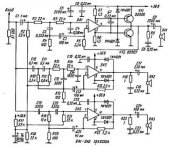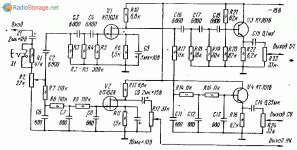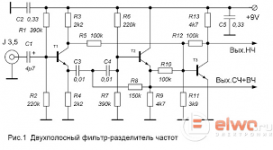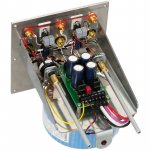That depends on the user, it is important to set the gain properly. Anyway i already advised capacitor coupled amplifier for tweeter section.
And how can i lower the gain of lm1875? And how works the capacitor coupling?That depends on the user, it is important to set the gain properly. Anyway i already advised capacitor coupled amplifier for tweeter section.
Okey, thanks 😉A potentiometer in front of it is the simplest solution.
i am making lm1875 bi-amp
Attachments
If i lower the gain using patentiometer will it also reduce power consumption?A potentiometer in front of it is the simplest solution.
The power consumption of a typical linear, class AB amplifier (i.e. no other features or functions included) is proportional to the power output + its DC bias or idle current losses, through the resistive heating and EMR or radiation losses of components, wiring, PCB traces and (assuming there is one) the power transformer itself. So-o-o-o, when the volume is reduced, so is the power consumption, until the idle current or bias threshold alone is reached, when there is no signal to amplify at all. That's the minimum power consumption level of the amplifier.
Other classes of amplifier have quite different amounts of power consumption, with basic class A operation often chewing up full power all the time and classes C and D being considerably more efficient than virtually anything else. Look up the topics of audio amplifier efficiencies and classes for yourself in any recognised online or printed audio design text.
www.desmith.net/NMdS/Data/Books%20and%20Manuals/Self%20-%20Audio%20Power%20Amp%20Design%20Handbook%204th%20Edn.pdf
Other classes of amplifier have quite different amounts of power consumption, with basic class A operation often chewing up full power all the time and classes C and D being considerably more efficient than virtually anything else. Look up the topics of audio amplifier efficiencies and classes for yourself in any recognised online or printed audio design text.
www.desmith.net/NMdS/Data/Books%20and%20Manuals/Self%20-%20Audio%20Power%20Amp%20Design%20Handbook%204th%20Edn.pdf
Last edited:
Disagree with the above... I have a good quality US designed and made Lm3886 amp. Imo there are better and far worse ones though.I'd avoid posting harsh personal comments and judgements like those above, about any member, new or experienced here.
LM1875 though, is still great bangs-per-buck. I was given a very well planned and pre-assembled Chinese board for testing some weeks ago and it sounded every bit as good as typical LM3886 type builds.
Recently completed an 1875 amp. Using the 'good' but cheap Chinese PCB, substituting EVERY part on it with genuine ones from Mouser.
Also turned out to be Far more expensive than first assumed
Fortunately It sounds decent .
But in No way does it match my 3886 amps' bass dynamics, depth of field or sparkly highs.
Then you misread my use of the term "typical LM3886 builds". Most I have listened to for any length of time and usually on more than one occasion, tend to be pretty dull, due sometimes to severe economies so they probably don't reach even the basic performance level of the original app notes. Naturally, when you compare with larger chipamps and appropriately larger power supplies, you will lose bass extension and probably experience some compression. Horses for courses, as they say.
I also don't think that throwing money into over-specified components like resistors should improve anything over standard grades anyway, whether it's a discrete design or chipamp. Any improvements would be in the logic of the application design, PCB layout and power supply, not wasted on high precision, mil. grade components, for example. However, there are obviously many committed enthusiasts out there who don't use logic but do have buckets of cash to spend on projects as they are led to believe is necessary. I'd say though, show us the proofs.
I also don't think that throwing money into over-specified components like resistors should improve anything over standard grades anyway, whether it's a discrete design or chipamp. Any improvements would be in the logic of the application design, PCB layout and power supply, not wasted on high precision, mil. grade components, for example. However, there are obviously many committed enthusiasts out there who don't use logic but do have buckets of cash to spend on projects as they are led to believe is necessary. I'd say though, show us the proofs.
Last edited:
Have you ever read about the "Blok20"? It's a 2x 20W stereo amp, built after the same schematic as the well known 1,80€/$ "China Blue" mini mono (fake) LM1875 kit. The components are quite solid, good quality, a massive toroid, a nice case. I'd say 150€/$ material, where the biggest part is the psu and the enclosure. > PTP Audio - BLOK20 - take a look, and take a look at the price. I doubt thet they will sell much of these amps, but it's a small business, so they won't sell much of anything. The thing is, a well built LM1875 with a high quality psu in combination with high quality/ efficiency speakers will sound for someone who is just into music and not into electronics, like an amp, worth the money they are calling for it 😉 .
Attachments
I've only seen a couple of posts mentioning the Blok20 but the power amplifier section does appear to be a conventional application note build with an open chassis, hard wired assembly. I guess that adds visual emphasis to the grounding and like it says, seems to use some existing stock components and materials for economy. 'Not sure about that plastic selector switch but I imagine it works as it should for some time at least.
Many years ago, I built a number of LM1875 amps into die-cast or extruded aluminium section boxes, including a standard 80 - 120VA toroidal transformer PSU. It was puzzling though, that some sounded great and others not. It proved to be the LM1875s themselves that were mostly to blame and this became my first experience of fake semis. Those and other fakes are still out there in abundance though and I wonder how many "expert listener" opinions are based on them.
Otherwise, I have a lot of respect for the chip since a decent build will often surpass midrange discrete amplifiers and as suggested, a DIY beginner with a good quality PCB design but only a small budget, can get into hi-fi at a very affordable price.
Many years ago, I built a number of LM1875 amps into die-cast or extruded aluminium section boxes, including a standard 80 - 120VA toroidal transformer PSU. It was puzzling though, that some sounded great and others not. It proved to be the LM1875s themselves that were mostly to blame and this became my first experience of fake semis. Those and other fakes are still out there in abundance though and I wonder how many "expert listener" opinions are based on them.
Otherwise, I have a lot of respect for the chip since a decent build will often surpass midrange discrete amplifiers and as suggested, a DIY beginner with a good quality PCB design but only a small budget, can get into hi-fi at a very affordable price.
Last edited:
I think it is not right to compare a current limited 20w chipamp with 70w 7A(guaranteed limit) capable amplifier, although there is no doubt that Lm1875 is a decent audio amplifier. Personally i like 5pin chipamp more than their big brothers.
I had my first time with a five legger ... it was wonderful ... 😉 . Serious, the LM1875 kit with the tiny blue PCB was the bait that hooked me.Personally i like 5pin chipamp more than their big brothers.
A comparison with larger chipamps (#56) can be fair when you consider the actual listening levels of users. As another very popular example of low power here, there are lots and lots of JLH'69 users and despite its low 10W capability, they continue to praise its virtues everywhere on this forum, like it was their best amp and daily drive.
It goes back a few years but I tested a few friends' systems for them and showed that even at just a few watts peak output, the level was sufficient for serious listening with good quality, moderately sensitive speakers. That does depend on impedance too, so there is more to power capability than just having plenty of overkill at the ready. Bookshelf speakers for example, may look right for a low power system but it's likely that the efficiency of larger baffles and bass drivers will give much better overall results.
It goes back a few years but I tested a few friends' systems for them and showed that even at just a few watts peak output, the level was sufficient for serious listening with good quality, moderately sensitive speakers. That does depend on impedance too, so there is more to power capability than just having plenty of overkill at the ready. Bookshelf speakers for example, may look right for a low power system but it's likely that the efficiency of larger baffles and bass drivers will give much better overall results.
- Home
- Amplifiers
- Chip Amps
- LM1875 Bi-amp



